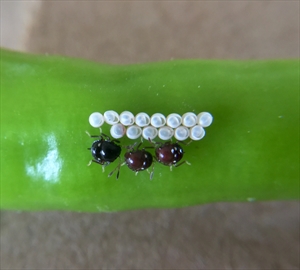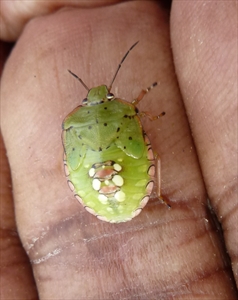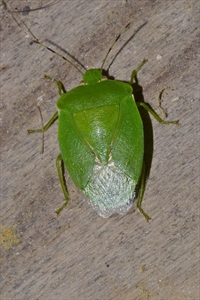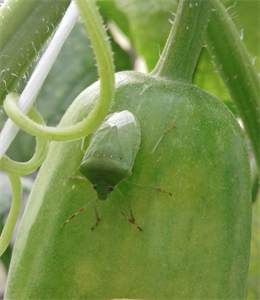Green vegetable bug; green stink bug; green shield bug; southern green stink bug.
Pacific Pests, Pathogens, Weeds & Pesticides - Online edition
Pacific Pests, Pathogens, Weeds & Pesticides
Green vegetable bug (098)
Nezara viridula
Asia, Africa, North, South and Central America, the Caribbean, Europe, Oceania. It is recorded from Australia, American Samoa, Cook Islands, Federated States of Micronesia, Fiji, Kiribati, New Caledonia, New Zealand, Niue, Northern Mariana Islands, Palau, Papua New Guinea, Samoa, Solomon Islands, Tonga, Vanuatu, and Wallis & Futuna.
Common on brassicas, capsicum, cucumber and other cucurbits, and legumes, including yard long beans. It is also a pest of tomato. Many other plants, including weeds, are attacked by this insect, which has a very wide host range.
The stink bug is common worldwide attacking a very wide range of vegetables, food legumes and some fruits. The bugs have needle-like mouthparts and use them to feed on developing flowers, fruits and seeds. The punctures produce brown or black spots. On yard long bean, for instance, the bugs suck the seeds and the pods become misshapen and shriveled. On tomatoes, fruits mature early and fruit size and weight is reduced.
Nezara is a major pest. The bugs have needle-like mouthparts and use them to feed on developing flowers, fruits and seeds. The punctures produce brown or black spots. On yard long bean, for instance, the bugs suck the seeds and the pods become misshapen and shriveled. On tomatoes, fruits mature early and fruit size and weight is reduced.
Eggs, cream to yellow, are laid in batches of 50 to 100 on the undersides of leaves (Photo 1). The nymphs are at first black and stay together around the egg shells, but as they grow and moult (there are five nymph stages) more of their bodies become green (Photos 2-4), and they stay alone. When adult, they are about 15 mm long and 8 mm wide (Photos 5&6). The lifecycle takes about 35 days in the tropics. There is little information from Pacific islands countries about the plants that the bug breeds on. In other countries, soybean, thistles and rice are major hosts.
The bugs are strong flyers and will fly away when disturbed. Also, when disturbed they release a strong foul smell, hence the name 'stink bug'.
Nezara is a major pest. Much of the damage caused by the insect is due to the reduction in seed germination. Studies done on cowpeas, a close relative of yard long bean, showed that damage to seeds can be high even with relatively few bugs, about 12 per metre of row.
Feeding punctures of the green vegetable bug also cause indirect damage. The punctures allow the entry of fungi and bacteria that cause secondary spots and rots.
Look for a large green bug with long needle-like mouthparts often feeding on the seeds of yard long beans, and other seed legumes and tomatoes. Look for nymphs, black with rows of white and later yellow spots. Look for the bugs early in the day when they bask in the sun; later, at midday, they retreat into the canopy. There is a video on sampling using a beat sheet (http://www.youtube.com/watch?v=56OB-tE3x18).
NATURAL ENEMIES
Although many parasitoids (small wasps and flies) and parasites have been recorded, few appear to impact on populations of the bug, except for one, Trissolcus basalis, an egg parasitoid. In Brazil, for instance, this insect is mass-reared for release in soybeans. It has been introduced into Australia on several occasions from different parts of the world, into Cook Islands, Hawaii, Kiribati, New Caledonia, New Zealand, Samoa, Solomon Islands, Tonga and Vanuatu, generally with positive results. However, Waterhouse & Norris (1987) suggest where it is present, but ineffective, additional strains should be sought.
In many counties, ants are said to achieve high levels of biocontrol. One ant common in Pacific island countries - the big-headed ant (Pheidole megacephala) - is said to take the eggs and young nymphs to its nest.
CULTURAL CONTROL
Before planting:
- Consider small fruiiting varieties that may suffer less damage.
- Make sure you are planting in healthy soil (see Fact Sheet no. 468).
- Avoid planting crops of beans, brassicas, cucurbits, tomato, etc. next to older infested ones as the bugs easily fly to the new crop.
- Avoid planting downwind from infested crops.
- Remove weeds from around the nursery (and from within and around the field before transplanting).
During growth:
- Weed around the crop, as many weeds are breeding hosts for the green vegetable bug.
- Squash any eggs, nymphs, or adults during weekly visits.
- Plant a trap crops such as rattle pod, Crotalaria; the bug favours Crotalaria over many crop plants.
- Plant flowering plants as a border to attract parasitoid wasps.
- Bag fruits or wrap in newspaper if infestations are severe.
After harvest:
- Collect the remains of the crop and burn or bury.
CHEMICAL CONTROL
- Use plant-derived products (see Fact Sheet no. 56), such as derris, pyrethrum, chilli (see Fact Sheet no. 504), and neem (see Fact Sheet no. 402), with the addition of soap.
- Note some vegetable-based white oils contain neem and could be tested. Likewise, horticultural oils containing neem may be effective.
- Alternatively, use synthetic pyrethroids; they are likely to be effective, but will also kill natural enemies (wasps and ants).
--------------------
Note, derris (Derris species) contains rotenone, an insecticide, often used as a fish poison; it should be used with caution. The commercial derris insecticide is made from Derris elliptica.
____________________
When using a pesticide, always wear protective clothing and follow the instructions on the product label, such as dosage, timing of application, and pre-harvest interval. Recommendations will vary with the crop and system of cultivation. Expert advice on the most appropriate pesticide to use should always be sought from local agricultural authorities.
AUTHORS Grahame Jackson, Mani Mua & Helen Tsatsia
Information from CABI (2017) Nezara viridula (green stick bug) Crop Protection Compendium (https://www.cabi.org/cpc/datasheet/36282); and Nezara viridula (Linnaeus) Entomology & Nematology. UF/IFAS, University of Florida. (http://entnemdept.ufl.edu/creatures/veg/bean/southern_green_stink_bug.htm); and Waterhouse DF, Norris KR (1987) Nezara viridula (Linnaeus). Biological Control Pacific Prospects. Inkata Press; and Nezara viridula. Wikipedia. (https://en.wikipedia.org/wiki/Nezara_viridula); and from Martin NA (2018) Green vegetable bug - Nezara viridula. (https://nzacfactsheets.landcareresearch.co.nz/factsheet/InterestingInsects/Green-vegetable-bug---Nezara-viridula.html). Photo 5 Cameron Prybol, Department of Biochemistry and Molecular Biology, The University of Georgia, USA.
Produced with support from the Australian Centre for International Agricultural Research under project PC/2010/090: Strengthening integrated crop management research in the Pacific Islands in support of sustainable intensification of high-value crop production, implemented by the University of Queensland and the Secretariat of the Pacific Community.









